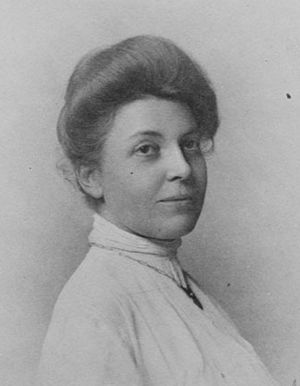Clara Barck Welles facts for kids
Clara Pauline Barck Welles (born 1869, died 1965) was a talented American silversmith. She was also a strong supporter of women's right to vote, known as a suffragist, starting around 1910.
In 1900, after finishing her studies in decorative design at the School of the Art Institute of Chicago, Clara had a great idea. She asked five friends from her class to join her in starting a business called the Kalo Shop. There, they made beautiful items like jewelry, fabrics, and leather goods.
Later, by the late 1930s, Clara's business focused mainly on silverware. She employed about 25 silversmiths, many of whom were immigrants from Scandinavia. Her amazing creations were even shown in an exhibit at the famous Museum of Modern Art.
Clara's Early Life and Business
Clara Pauline Barck was born on August 4, 1868, in Ellenville, New York. Her father, Johannes Barck, was a shoemaker from Finland. Her mother, Margaret, came from Switzerland. Clara was the fourth of their six daughters.
When Clara was 10, her family moved to a farm in Oregon City, Oregon. Her father passed away when she was 15. After that, the women in the family managed the farm. Clara first worked at a woolen mill. Then, she took a course at a business college. From 1890, she worked in bookkeeping and sales at large stores in Portland and San Francisco.
In 1898, the family farm was sold. Clara then moved to Chicago. There, she studied decorative design at the School of the Art Institute of Chicago. Soon after graduating in September 1900, she and five classmates opened the Kalo Shop. They created and sold crafts like book plates, jewelry, metalwork, and leather items.
In 1905, Clara married George S. Welles, who also worked with metal. The next year, they moved their business to Park Ridge, a suburb of Chicago. They opened the Kalo Shop Arts Crafts Workshop in a large farmhouse. They hired art school graduates and skilled metalworkers from Scandinavia. These workers made silverware and jewelry.
The couple also started a craft school and held art exhibitions. Their business grew very large, employing over 50 people. It became one of the biggest companies in the area.
Fighting for Women's Rights
In 1910, Clara Barck became very involved in the movement for women's suffrage. This was the fight to give women the right to vote. She joined a group called the Chicago Political Equity League.
In 1912, Clara was chosen to lead the Park Ridge Improvement Association. The next year, she led the Parade Committee for the Illinois group in the "Votes for Women Procession" in Washington D.C. She was very excited and led a large group of marchers.
In 1914, Clara spoke at a big meeting at Chicago's Auditorium Theatre. Also in 1914, she hosted a special event at her Kalo Shop. She invited many important women to help raise money. About 100 women attended, and they donated pieces of gold or silver to be melted down.
Later Years
In 1916, Clara's marriage ended. After this, she reorganized her Kalo shops and how they made things. In the 1920s, her business did very well. However, during the Great Depression, her staff was reduced to just four people.
In 1936, she moved the Kalo Shop to Michigan Avenue in Chicago. It stayed there for the next 34 years. In the 1940s, Clara Barck Welles moved to San Diego. She passed away on March 14, 1965, at the age of 96.



